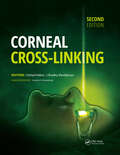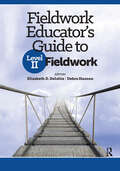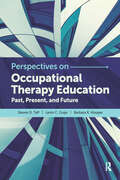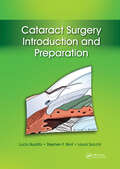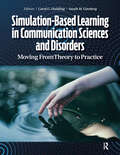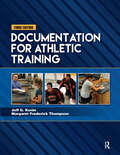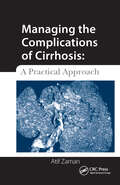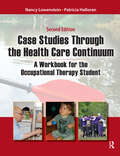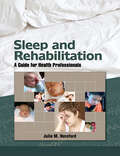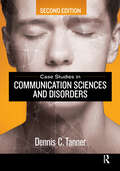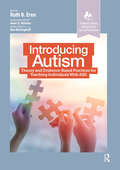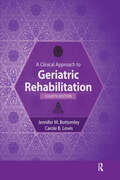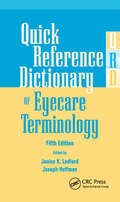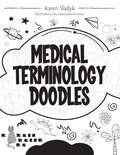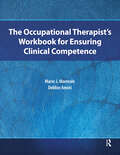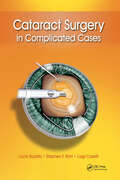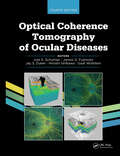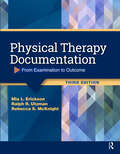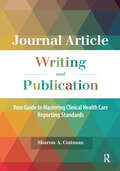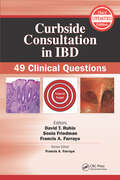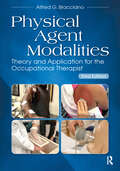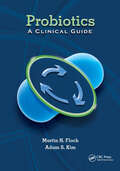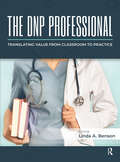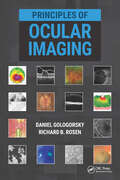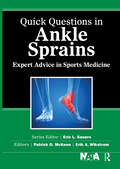- Table View
- List View
Corneal Cross-Linking
by J. Bradley Randleman Farhad HafeziCorneal Cross-Linking, Second Edition represents an innovative approach to treating primary acquired and secondary induced ectatic disorders. In addition, corneal cross-linking (CXL) has promising applications as an alternative in the treatment of corneal infectious and non-infectious melting, as well as conditions such as Fuchs’ endothelial dystrophy. The new and expanded Second Edition of Corneal Cross-Linking by Drs. Farhad Hafezi and J. Bradley Randleman will provide a concise yet comprehensive summary of the CXL process, including the basic science foundations, treatment protocols and outcomes, recognition and management of potential complications, and modification of standard protocol for special circumstances. Given all the changes in this rapidly progressing field, many brief topics from the first edition have now grown into full chapters or sections. These include expanded sections on alternative treatment protocols, corneal imaging and biomechanics, combing cross-linking with other refractive treatments, and a section devoted specifically to the most highly debated controversies in the field today. With each chapter being fully updated plus including over twenty new chapters that covers the latest advances and future directions, Corneal Cross-Linking, Second Edition represents the cutting-edge of CXL research and clinical practice. “Since the publication of the first edition of this book in 2013, our knowledge of corneal cross-linking has again significantly increased, both scientifically and clinically. Today, concise recommendations (guidelines for cross-linking) help the clinician to select the patients, make decisions, and provide optimal treatment” -Eberhard Spoerl, PhD and Theo Seiler, MD, PhD
Fieldwork Educator’s Guide to Level II Fieldwork
by Debra Hanson Elizabeth DeIuliisA new, comprehensive resource for fieldwork educators and academic fieldwork coordinators, Fieldwork Educator’s Guide to Level II Fieldwork provides a blueprint for designing, implementing, and managing Level II fieldwork programs for occupational therapy and occupational therapy assistant students across practice settings.Drawing from the expertise of renowned individuals in the field, Drs. Elizabeth D. DeIuliis and Debra Hanson provide the tools for fieldwork educators and academic fieldwork coordinators to put together learning frameworks, educational theories, and clinical instructional techniques within and outside occupational therapy in order to create and maintain high-quality Level II learning experiences. Fieldwork Educator’s Guide to Level II Fieldwork challenges fieldwork educators and academic fieldwork coordinators to shift their mindset to facilitating skill acquisition and to adjust their teaching approach to match the learning needs and developmental level of the student.Designed to meet the definition of Level II fieldwork according to the 2018 Accreditation Council for Occupational Therapy Education standards, and in response to common pitfalls and challenges in clinical education today, Fieldwork Educator’s Guide to Level II Fieldwork is the go-to guide for the busy practitioner and academic fieldwork coordinator.What is included in Fieldwork Educator’s Guide to Level II Fieldwork: Expansive overviews of supervision models and vignettes illustrating use across practice settings Examples and templates to construct a learning plan, site-specific learning objectives, orientation, weekly schedules, and learning contracts Tools and strategies to uniquely develop and foster clinical reasoning in fieldwork Models for dually approaching supervision and mentorship Strategies for addressing unique student learning and supervision needs Fieldwork Educator’s Guide to Level II Fieldwork can be used as a standalone resource or as a complement to Fieldwork Educator’sGuide to Level I Fieldwork, which was designed in-tandem with this text to holistically address Levels I and II fieldwork education
Perspectives on Occupational Therapy Education: Past, Present, and Future
by Barbara Hooper Steven Taff Lenin GrajoPerspectives on Occupational Therapy Education: Past, Present, and Future outlines a path forward for occupational therapy educators, incorporating the impact of historical context, contemporary issues and trends, and international viewpoints on the development of the profession.With this mission in mind, Drs. Steven D. Taff, Lenin C. Grajo, and Barbara R. Hooper offer helpful tips, practical tools, and fresh insights to support current and future educators in developing their teaching philosophies and pedagogies. The book is divided into three main sections—past, present, and future—and examines:• The history of occupational therapy education, including the influence of critical philosophies, their relationship to higher education and healthcare, and the growth of accreditation standards and professional degree programs.• Current trends and challenges in healthcare and higher education, including bridging the gap between education and practice, the use of competency exams, expanding educational research, and promoting diversity and inclusion among faculty and students.• International perspectives on the development and future of occupational therapy education from leading scholars in Africa, Australia, Europe, North America, South America, and Southeast Asia, including trends in educational technologies, fieldwork education and requirements, and inter-professional education.An indispensable resource for educators, Perspectives on Occupational Therapy Education: Past, Present, and Future concludes with an imagining of the occupational therapy education landscape in the year 2050: a future in which occupational therapy educators are continuously responding to ongoing changes in health care policies, adapting to a more diverse and globally connected student population, and articulating the distinct value of occupational therapy in new and emerging areas of practice.Included with the text are online supplemental materials for faculty use in the classroom.
Cataract Surgery: Introduction and Preparation
by Lucio Buratto Stephen Brint Laura SacchiCataract Surgery: Introduction and Preparation offer the latest information and examines the most popular instruments used, the preoperative examination, and the operating technique for cataract surgery. Dr. Lucio Buratto, Dr. Stephen Brint, and Dr. Laura Sacchi provide a step-by-step approach to facilitate assessing the patient, performing the technique, and managing cataract surgery in the most optimal way possible. Cataract Surgery: Introduction and Preparation will lead beginning surgeons down the exciting path of cataract surgery as they increase their knowledge of phacoemulsification and the femtolaser by learning all the details associated with the procedures. Cataract Surgery: Introduction and Preparation covers a wide variety of topics, including presurgery examination, incisions, capsulorhexis, hydrodissection, prevention of endophthalmitis, and ophthalmic viscosurgical devices for modern cataract surgery. Supplemented by more than 200 color illustrations, diagrams, a glossary, and references, all surgeons from beginner to expert will want this unique resource by their side.
Simulation-Based Learning in Communication Sciences and Disorders: Moving from Theory to Practice
by Sarah Ginsberg Carol DuddingA new resource for academic and clinical educators, Simulation-Based Learning in Communication Sciences and Disorders: Moving From Theory to Practice presents best practices in simulations for undergraduate, graduate, and workplace training programs in audiology, speech-language pathology, and communication sciences and disorders.Utilizing the expertise of experienced clinical educators, Simulation-Based Learning in Communication Sciences and Disorders is an introductory to intermediate text for those interested in implementing clinical simulations within undergraduate and graduate training programs, as well as the workplace. To that end, it includes descriptions of various simulation technologies, ranging from low to high fidelity, as well as examples for implementation.The text is divided into three main sections: Foundations in Clinical Simulations provides an overview of foundational theories in simulation-based learning and principles of teaching and learning in higher education Clinical Simulation Learning Experiences expands upon the various forms of simulation technology, outlines the best practices for implementing simulations for learning, and identifies ways for educators to incorporate simulation technologies into their curriculum Professional Issues and Advocacy calls on readers to engage in professional development and research in the area of simulations; readers are encouraged to consider ways in which existing and emerging technologies can help us adapt to the upcoming changes in education and training Simulation-Based Learning in Communication Sciences and Disorders: Moving From Theory to Practice is one of the first books to integrate best practices in simulation research and practice specifically for academics and clinical educators in communication sciences and disorders. It is an invaluable guide to anyone who is interested in providing high-quality learning experiences through simulation to students and professionals in communication sciences and disorders.
Documentation for Athletic Training
by Jeff G. Konin Margaret Frederick ThompsonDocumentation for Athletic Training, Third Edition provides all the important and relevant information that a practicing athletic trainer needs to possess to provide accurate documentation. These topics include legal considerations, electronic medical records, and numerous tips for effective verbal and written communication styles. This Third Edition by Drs. Jeff G. Konin and Margaret Frederick Thompson continues to provide a plethora of standard templates to refer to as examples of the most commonly used forms in athletic training practice settings. The authors represent decades of collective experience as clinicians, educators, and administrators and offer insight on the importance of timely and appropriate methods for athletic training documentation.Documentation for Athletic Training, Third Edition has strengthened chapters on electronic documentation and documentation for reimbursement. These are continuously-evolving areas that require an understanding of not just a single type of software system, but rather a foundation of knowledge related to the principles of each. Additionally, a chapter has been added on contemporary type of documentation. Communication in the forms of text messages, social media, and other common types of information sharing are discussed. Features inside the Third Edition: Learning objectives for each chapter “Pearls of Wisdom” on key points Discussion and study questions Worksheets and commonly used documentation forms Glossary of terms Symbols and medical terminology abbreviations Documentation for Athletic Training, Third Edition continues to be the only textbook dedicated to the topic of documentation and presents a wide array of methods and forms, providing students, educators, and clinicians with a multifaceted tool box for their documentation needs.
Managing the Complications of Cirrhosis: A Practical Approach
by Atif ZamanManaging the Complications of Cirrhosis: A Practical Approach is a simple pocket guide for the community gastroenterologist and primary-care provider who manages liver disease. While there are other books available on the market regarding the management of cirrhosis, this reference includes information geared toward the busy practitioner, allowing the reader to reference a chapter that easily addresses the clinical issue at hand. Dr. Atif Zaman provides essential and current information on the management of cirrhosis for the nonhepatologist.Each chapter in Managing the Complications of Cirrhosis: A Practical Approach is broken down into four sections, including a summary of the issue at hand, a diagnosis of the problem, a treatment algorithm, and what to do if the treatment algorithm is ineffective. In addition, each chapter highlights complex cases that have no standard treatment, but have emerging concepts or data.Chapter topics include:• Preventative health issues in patients with cirrhosis• Nutrition in patients with cirrhosis• Management of hepatocellular carcinoma• Pulmonary issues in patients with cirrhosis• Timing of referral for liver transplantWith algorithms and tables, Managing the Complications of Cirrhosis: A Practical Approach is the perfect book for all community gastroenterologists, primary-care practitioners, medical residents and fellows, physician assistants, and nurse practitioners who provide care in the area of liver disease.
Case Studies Through the Health Care Continuum: A Workbook for the Occupational Therapy Student
by Nancy Lowenstein Patricia HalloranThe extensively updated Second Edition of Case Studies Through the Health Care Continuum: A Workbook for the Occupational Therapy Student is a versatile resource that focuses on assisting students through the use of case studies. Through these 34 cases, students learn about the many possible choices in the clinical decision-making process, and how these different choices can lead to many equally successful outcomes.Case Studies Through the Health Care Continuum, Second Edition by Nancy Lowenstein and Patricia Halloran encompasses new and revised case studies across the health care continuum, from early intervention to older adults. These cases involve situations that students might encounter during their interventions and require them to think about issues that might occur to disrupt their original intervention plan.Inside Case Studies Through the Health Care Continuum, Second Edition, new questions on theory and evidence will allow students to think of theory-driven and evidence-based practice concepts, as well as search the literature to support their interventions. Care was also taken to avoid using a specific frame of reference or theoretical model to enable instructors to use various frames of reference and theories with different cases.New to the Second Edition: Each case allows the student to consider the client’s occupations, performance patterns, performance skills, client factors, contexts, and environments Case studies are now formatted around an Occupational Profile and an Analysis of Occupation, adhering to the AOTA’s Occupational Therapy Practice Framework language Pediatric case studies Increased number of community case studies Case study on primary care, an emerging practice area in occupational therapy Case studies involving complex conditions, not just one condition Case Studies Through the Health Care Continuum: A Workbook for the Occupational Therapy Student, Second Edition is a valuable learning tool for any occupational therapy or occupational therapy assistant student as it provides a way to put theories and clinical reasoning into practice through the use of case studies.
Sleep and Rehabilitation: A Guide for Health Professionals
by Julie HerefordSleep and Rehabilitation: A Guide for Health Professionalsis a concise reference for the health professional looking to further understand sleep and how sleep science may impact particular areas of various rehabilitation disciplines. Dr. Julie M. Hereford and her contributors present Sleep and Rehabilitation: A Guide for Health Professionalsin an easy-to-read manner by dividing the text into four main sections. The first section provides a review of the basic scientific understanding of sleep. While there are many other publications that present a basic scientific understanding of sleep, Sleep and Rehabilitation systematically gears this information toward the rehabilitation professional with commonly used terminology, descriptions of sleep architecture, and information concerning sleep hygiene. The middle sections of Sleep and Rehabilitationdescribe disordered sleep and how it pertains to patients seen in the rehabilitation setting. It guides the health professional to recognize the manifestations and consequences of disordered sleep and teaches the rehabilitation professional how to interpret a sleep study in order to provide guidance in clinical decision making. Finally, the last section of Sleep and Rehabilitationprovides the ever-important practical application of the theoretical principles in sleep rehabilitation.Features include: Discussion on the science of polysomnography Sleep and sleep dysfunction from a rehabilitation perspective Sleep dysfunction as it relates to the clinical needs of a patient undergoing the rehabilitation process Discussion on the particular concerns that sleep and sleep dysfunction can hold for rehabilitation patients and issues to be addressed by the provider Presentation of unique issues that disordered sleep may present in the rehabilitation process such as on pain, pain management, motor learning, and memory and performance enhancement Tools to assess quality and quantity of a patient’s sleep Discussion on methods in which sleep may be manipulated in order to optimize a patient’s physical performance Sleep and Rehabilitation: A Guide for Health Professionalsis a one-of-a-kind reference that will help the health professional incorporate the science of sleep into the rehabilitation process.
Case Studies in Communication Sciences and Disorders
by Dennis TannerThe discipline of communication sciences and disorders is an exciting field that appreciates the wonders and complexities of human communication. Case Studies in Communication Sciences and Disorders, Second Edition is an informative and relevant text that addresses the myriad disorders, deficits, diseases, and disabilities that can lay waste to the incredible systems involved in communication.Case Studies in Communication Sciences and Disorders, Second Edition by Dr. Dennis Tanner provides engaging factual and historical information about each of the major communication disorders. The case studies presented in each chapter uncover the functional barriers encountered by clients of practicing speech-language pathologists and audiologists. Each chapter provides a scholarly overview of a communication disorder with an emphasis on etiology, diagnosis, and treatment and uses several case studies to illustrate the many different presentations of each disorder. Over 50 case studies reflect true clinical practice and include detailed patient histories that give humanity and depth to the patient-clinician relationship.Chapter Topics in the Second Edition Include: Language delays and disorders Articulation and phonology disorders Stuttering Voice and resonance disorders Aphasia Motor speech disorders Dysphagia Traumatic brain injury Hearing loss and deafness Case Studies in Communication Sciences and Disorders, Second Edition is a relevant and readable text for speech-language pathology and audiology students and clinicians that takes theory and clinical reasoning and applies them to a variety of interesting cases.
Introducing Autism: Theory and Evidence-Based Practices for Teaching Individuals with ASD (Evidence-Based Instruction in Special Education)
by Ruth ErenWritten by educators for educators, Introducing Autism: Theory and Evidence-Based Practices for Teaching Individuals With ASD is an introductory text offering a broad picture of Autism Spectrum Disorder for students, teachers, related service providers, and other school personnel who are engaged in the education of individuals with ASD.Introducing Autism imparts knowledge and understanding of the broad spectrum of ASD and suggests evidence-based practices to support this population. Editor Dr. Ruth Eren and the text contributors provide readers with a firm foundation of facts, strategies, and processes that help explain and address the complex profile of an individual with ASD. As a result of this understanding, current and future practitioners will be equipped with the skills and strategies to work collaboratively and effectively with their school team as they create a program for a student on the spectrum.What’s included in Introducing Autism: Content supported by case studies based in authentic educational settings Evidence-based practices suggested for use in the classroom Voices from the Spectrum sections in each chapter which feature the viewpoints from individuals on the spectrum Introducing Autism: Theory and Evidence-Based Practices for Teaching Individuals With ASD will enable universities to offer a comprehensive course that provides a strong foundation of knowledge and understanding of ASD to prepare teachers and related service providers for certification.
A Clinical Approach to Geriatric Rehabilitation
by Carole Lewis Jennifer BottomleyThe field of geriatric rehabilitation is constantly changing due to the discovery of new evidence-based evaluation and treatment strategies, as well as the continual support or refutation of older theories and practices. Now in itsFourth Edition, A Clinical Approach to Geriatric Rehabilitation has been updated to be at the forefront of these changes and includes free video content from MedBridge and a discount on a MedBridge subscription to geriatric rehabilitation courses offered by the authors.Drs. Jennifer M. Bottomley and Carole B. Lewis have compiled the plethora of available scientific research on geriatric populations and combined it with their years of actual clinical practice. Together this makes this text a complete evidence-based guide to the clinical care of geriatric patients and clients.The first part of A Clinical Approach to Geriatric Rehabilitation, Fourth Edition tackles applied gerontological concepts, providing the general knowledge base necessary for treating geriatric patients. Topics in this section include patient evaluation, an exploration of nutritional needs, and age-related changes in physiology and function, as well as many other foundational areas.In the second section, topics become more focused on patient care concepts like neurologic considerations, cardiopulmonary and cardiovascular considerations, and establishing community-based screening programs.In the final section, chapters center on administration and management, including important subjects such as attitudes, ethics, and legal topics, as well as consultation and research.New and updated in the Fourth Edition: Pearls section for succinct highlights of the content within each chapter The latest evidence-based practice interventions with complete references for further reading Updated graphics, pictures, and diagrams to illustrate the content Content summaries and streamlined text for enhanced readability Updated case studies to exemplify clinical decision-making Designed to provide valuable, real-life clinical knowledge, A Clinical Approach to Geriatric Rehabilitation, Fourth Edition gives physical therapists an evidence-based guide to the clinical aspects of rehabilitative care in older adult patients and clients.
Quick Reference Dictionary of Eyecare Terminology
by Janice K. Ledford Joseph HoffmanA leading resource for nearly two decades and a daily reference for thousands of eyecare professionals, the Fifth Edition of Quick Reference Dictionary of Eyecare Terminology continues this tradition and provides the latest terms, concepts, conditions, and important resources in an instant. Janice K. Ledford and Joseph Hoffman have updated and expanded this essential resource to reflect today’s dialect while retaining the core features associated with this user-friendly reference book: accurately defined terms, cross-referencing, acronyms and abbreviations, and a plethora of additional information in the appendices. Compact, concise, and informative, Quick Reference Dictionary of Eyecare Terminology, Fifth Edition, provides quick access to over 3,700 terms and their definitions, including over 400 new words. This pocket-sized companion also contains 25 appendices. Additionally, pronunciations have been added—an attribute users are sure to appreciate. With a history of excellence, an easy-to-use format, and the latest information, Quick Reference Dictionary of Eyecare Terminology, Fifth Edition is a must have for anyone working in eyecare or an eyecare-related industry.Features: An atlas of ocular anatomy drawings Updated list of pertinent web sites Updated drug tables A reading guide Appendices Include: Medical terminology Subjective grading systems Common abbreviations The metric system English-to-Spanish ocular history flow sheet
Medical Terminology Doodles
by Karen SladykToday's students have expressed a strong preference for multiple modes of information delivery, including visual, auditory and kinesthetic. Medical Terminology Doodles by Dr. Karen Sladyk is a unique book based on evidence that suggests that a multi-sensory approach that includes doodling can promote better knowledge retention than traditional methods in learning medical terminology.Medical Terminology Doodles offers 266 of the most common medical terms to explore and learn through doodling. By drawing or doodling related images, students will create permanent connections between the brain and the terms, as well as their root words, prefixes, and suffixes. Study hints, spelling hints, and sample illustrations are offered for each of the words, but students are also encouraged to personalize their learning by assigning meaning to the terms and creating their own “art.” Using visual cues to remember information will encourage students to review the material at hand and will also help them understand the way that terms connect to larger medical concepts. Medical Terminology Doodles is a must-have for students looking for a unique manner in which to engage with complicated scientific material. On the road to becoming a successful practitioner in the health professions, you can never underestimate the power of a doodle!
The Occupational Therapist’s Workbook for Ensuring Clinical Competence
by Marie Morreale Debbie AminiThe Occupational Therapist’s Workbook for Ensuring Clinical Competence is designed to help occupational therapy students and new practitioners demonstrate the practical problem-solving and real-life clinical reasoning skills essential for fieldwork and clinical practice. This user-friendly resource helps the reader apply occupational therapy concepts, improve narrative and pragmatic reasoning skills, and measure attainment of knowledge and skills needed for successful transition to fieldwork and entry-level practice.Inside The Occupational Therapist’s Workbook for Ensuring Clinical Competence, a wide variety of client conditions, situations, and intervention options are presented for different practice areas. Knowledge and skills are assessed for fundamental aspects of occupational therapy such as: professionalism, ethical decision-making, evidence-based practice, evaluation and intervention planning, occupation-based interventions, effective communication, supervision, role delineation, activity analysis, cultural competence, interprofessional collaboration, group process, emerging practice areas, department management, safety, documentation, billing and reimbursement, and more.Marie Morreale and Debbie Amini have incorporated numerous worksheets, learning activities, and worksheet answers in an easy-to-read format. The variety of assessment methods and learning activities used throughout the text stem from the authors' combined decades of teaching experience and include: case studies; vignettes; multiple choice, matching and true/false questions; fill in the blanks; experiential activities and more. Topics are broken down into smaller units and explained step-by-step to allow for easy independent study.Thoroughly explained answers are provided so that readers can check their responses with suggested best practice.These worksheets and learning activities are also useful as role-playing exercises, studying in small groups, and can aid in preparing for fieldwork or the national certification exam.Included with the text are online supplemental materials for faculty use in the classroom.The Occupational Therapist’s Workbook for Ensuring Clinical Competence is the go-to text for occupational therapy students and faculty, as well as new occupational therapy practitioners who require the practical problem-solving skills and the clinical decision-making skills essential for fieldwork and clinical practice.
Cataract Surgery in Complicated Cases
by Luigi Caretti Lucio Buratto Stephen BrintCataract Surgery in Complicated Cases offer the latest techniques in treating complicated cases as faced by today’s surgeons performing cataract surgery. Dr. Lucio Buratto; Dr. Stephen Brint; and Dr. Luigi Caretti provide step-by-step approach to facilitate how to assess the patient, perform the technique, and manager the most challenging cataract surgery complicated cases facing both beginning and experienced surgeons.Cataract Surgery in Complicated Cases covers a wide variety of topics including cataract in high myopia, floppy iris syndrome, traumatic cataract, phacoemulsification with a small pupil, and IOL explanation and replacement.Supplemented by more than 250 color illustrations, diagrams, a glossary, and references, all surgeons, from beginner to expert will want this unique resource by their side.
Optical Coherence Tomography of Ocular Diseases
by James G. Fujimoto Hiroshi Ishikawa Joel S. Schuman Jay DukerThe most comprehensive text and definitive guide for nearly 30 years about optical coherence tomography (OCT) imaging in ophthalmology, Optical Coherence Tomography of Ocular Diseases, Fourth Edition covers a range of subjects, from principles and operation techniques to clinical interpretation and the latest innovations in OCT. Written by the pioneers of OCT technologies and the world-renowned OCT researchers Drs. Joel S. Schuman, James G. Fujimoto, Jay S. Duker, Hiroshi Ishikawa, and Gadi Wollstein, Optical Coherence Tomography of Ocular Diseases, Fourth Edition is an essential text for imaging technology.OCT now occupies a dominant role as a diagnostic tool for retinal conditions and glaucoma. At the same time, the technology continues to show potential for emerging clinical and research applications across all the ophthalmological subspecialties. To reflect these rapid advances, this new edition of Optical Coherence Tomography of Ocular Diseases features a complete and thorough revision of the existing text as well as the addition of cutting-edge content to bring this classic resource completely up to date.New content in the Fourth Edition includes:• OCT angiography• Swept-source OCT• OCT in multimodal imaging• Clinical utility of OCT in glaucoma prediction and progression detection • OCT for neuro-ophthalmology Optical Coherence Tomography of Ocular Diseases, Fourth Edition is the one and only book needed by practitioners who use OCT for clinical eye care.
Physical Therapy Documentation: From Examination to Outcome
by Mia Erickson Rebecca McKnight Ralph UtzmanNewly updated and revised, Physical Therapy Documentation: From Examination to Outcome, Third Edition provides physical therapy students, educators, and clinicians with essential information on documentation for contemporary physical therapy practice.Complete and accurate documentation is one of the most essential skills for physical therapists. In this text, authors Mia L. Erickson, Rebecca McKnight, and Ralph Utzman teach the knowledge and skills necessary for correct documentation of physical therapy services, provide guidance for readers in their ethical responsibility to quality record-keeping, and deliver the mechanics of note writing in a friendly, approachable tone. Featuring the most up-to-date information on proper documentation and using the International Classification of Functioning, Disabilities, and Health (ICF) model as a foundation for terminology, the Third Edition includes expanded examples across a variety of practice settings as well as new chapters on: Health informatics Electronic medical records Rules governing paper and electronic records Billing, coding, and outcomes measures Included with the text are online supplemental materials for faculty use in the classroom.An invaluable reference in keeping with basic documentation structure, Physical Therapy Documentation: From Examination to Outcome, Third Edition is a necessity for both new and seasoned physical therapy practitioners.
Journal Article Writing and Publication: Your Guide to Mastering Clinical Health Care Reporting Standards
by Sharon A. GutmanThe ability to demonstrate that a specific health care profession provides valuable and effective services that meet society’s health needs is a major objective for all health care academicians and researchers. Such skills are critical to ensure service reimbursement from an increasingly small pool of health care dollars. Demonstrating clinical effectiveness depends on the reporting of written research results through journal publication so that the health care community and larger society will be able to access and read evidence supporting health care services. Today, several clinical reporting standard guidelines have been created by researchers to enhance the ability of readers to evaluate the quality and value of studies. Journal Article Writing and Publication is the first text to compile those clinical research reporting standards in one source and helps educators and novice researchers to better understand the skills needed for journal publication. Health care researchers must begin using these reporting standards in order to write manuscripts that are both correctly formatted and transparently convey all critical study strengths and limitations. Educators must teach these reporting standards to students who must evaluate research reports as consumers and possible future contributors to the literature through their own writing.Journal Article Writing and Publication by Dr. Sharon A. Gutman (a former editor of the American Journal of Occupational Therapy) provides specific guidelines, based on the most commonly accepted reporting standards, for the preparation and writing of general research studies, intervention effectiveness studies, instrument development and testing studies, and case reports. A section is devoted to helping authors understand the rules governing the reporting of statistical data in text and tables. Separate sections help authors understand the manuscript preparation and submission process, the revision process, and the etiquette guiding communication with editors and reviewers. Guidelines for the preparation of scholarly discussion papers and editorials are also provided.Journal Article Writing and Publication also features a section that aims to help doctoral students and newly minted faculty turn academic work and dissertations into publishable journal articles. Suggestions are provided to help clinicians turn clinical data into research databases that could serve as the foundation for pilot studies. Finally, information is provided to help authors better understand the ethical considerations of publication including plagiarism, dual submissions, inappropriate authorship, copyright, and conflict of interest.
Curbside Consultation in IBD: 49 Clinical Questions (Curbside Consultation in Gastroenterology)
by David T. Rubin Sonia Friedman Francis A. FarrayeNewly updated with the latest information on inflammatory bowel disease, Curbside Consultation in IBD: 49 Clinical Questions, Third Edition contains brief, practical, and evidence-based answers to the most frequently asked questions that are posed during a “curbside consultation” between surgical colleagues. Drs. David T. Rubin, Sonia Friedman, and Francis A. Farraye are joined by an expert group of contributors, offering advice, preferences, and opinions on tough clinical questions commonly associated with IBD. With a unique Q&A format, this text provides quick access to current information. Numerous images, diagrams, and references are included to better illustrate IBD.Some of the questions answered inside the Third Edition include: What are the new approaches to using and minimizing steroids? What is the evolving role of calcineurin inhibitors in IBD? Where should anti-IL-23 therapy be placed in the therapeutic algorithm for Crohn’s disease and ulcerative colitis? What should the clinicians and patients know about biosimilars? What are JAK inhibitors? And when should they be used in IBD? What is the approach to loss of response to biological therapy? How should we screen our patients with IBD for depression and anxiety? With information basic enough for trainees and expert practical advice that even high-volume clinicians will appreciate, Curbside Consultation in IBD: 49 Clinical Questions, Third Edition is a must-have. Gastroenterologists, surgeons, IBD nurses and advanced practice providers, and medical and surgical trainees at all levels will benefit from the user-friendly format and up-to-date advice for complicated cases.
Physical Agent Modalities: Theory and Application for the Occupational Therapist
by Alfred BraccianoThe popular occupational therapy textbook Physical Agent Modalities: Theory and Application for the Occupational Therapist has been newly updated and revised into a comprehensive Third Edition. Using current occupational therapy terminology and philosophy, this text establishes the theoretical basis and clinical reasoning for the use of physical agent modalities in practice. The biophysiological effects of the modalities are identified and discussed alongside their impact on function and performance. Relevant to both students and practitioners, the Third Edition educates on the proper, safe, and judicious use of physical agent modalities while treating clients.Written by Dr. Alfred G. Bracciano, this book outlines the application procedures for each modality, indications for their use, and the precautions and contraindications of the modality.New to the Third Edition: Organizational boxed asides and tables related to each concept area Evidence-based research boxes and tables related to clinical reasoning case studies New chapters on physiological impact of interventions, soft tissue techniques, and health care reform Global perspective providing a resource for the international therapist New color flow charts and improved graphics Each chapter contains: Learning objectives Key terms Case studies Included with the text are online supplemental materials for faculty use in the classroom.With up-to-date information and new chapters, Physical Agent Modalities: Theory and Application for the Occupational Therapist, Third Edition provides a user-friendly, organized reference ready to be applied in the clinical setting.
Probiotics: A Clinical Guide
by Martin Floch Adam KimProbiotics: A Clinical Guide is one of the first books on the market to present current and evidence-based recommendations for primary care providers and gastroenterologists on the use of probiotics as a way to treat specific diseases and disorders.Why you will want Probiotics: A Clinical Guide: Unique focus on the clinical use of probiotics in a wide variety of diseases Comprehensive review of the science behind probiotics and probiotic products In-depth review of current literature for specific diseases or disorders Recommendations of the use of probiotics is supported by evidence-based clinical trials Each chapter includes a table that outlines the exact probiotic organisms and dosages that are the most efficacious A glance at what is inside Probiotics: A Clinical Guide: Basic Physiology Intestinal microecology; stimulating the immune response, nutrients to nourish the organism, role in fermentation and metabolism, and much more… Use in Clinical Medicine Probiotics in children, adult infectious diarrhea, surgical infections, allergic disease, ulcerative colitis, crohn’s disease, liver disease, and more… Probiotics: A Clinical Guide by Dr. Martin Floch & Dr. Adam Kim is a ground-breaking book that will serve as a valuable reference and clinical guide for gastroenterologists, internists, family practitioners, nurse practitioners, and physician assistants.
The DNP Professional: Translating Value from Classroom to Practice
by Linda BensonThe DNP Professional: Translating Value from Classroom to Practice is a collection of exemplars from DNP (Doctor of Nursing Practice) -prepared experts across various advanced practice nursing roles and settings. The content illustrates the application of the American Association of Colleges of Nursing’s “Essentials,” quantifies successful DNP-prepared practitioner outcomes, and describes the overall impact of the nursing practice doctorate. Each chapter is written by a different expert and focuses on how the Essentials relate to that author’s role, including business planning, evidence-driven decision making, data analytics, and interprofessional collaboration. These leaders demonstrate how to implement lessons learned in a DNP program and translate them into everyday practice in every nursing domain, with plenty of pearls to pass along. Editor Linda A. Benson has divided the book into sections based on roles and settings: • Nurse Practitioner • Clinical Nurse Specialist • Certified Registered Nurse Anesthetists • Nurse Midwife • Nurse Executive • Academia • Population Health • Informatics • Legislative Activity When performing at their peak, DNPs can affect clinical, satisfaction, and cost outcomes, as well as provide preceptorship and mentoring. With exemplars from across the continuum of practice sites and roles, The DNP Professional: Translating Value from Classroom to Practice enables both students and DNP graduates to optimize the curricular Essentials in the practice setting.
Principles of Ocular Imaging
by Richard Rosen Daniel GologorskyAn essential text for the modern eye specialist, Principles of Ocular Imaging presents a comprehensive guide of all current ocular imaging modalities for ophthalmologists, optometrists, and those in training. Drs. Gologorsky and Rosen deliver a concise yet thorough overview of 22 imaging modalities unique to ophthalmology, emphasizing clinical application and replete with illustrative examples and ophthalmic images.Principles of Ocular Imaging is divided into the following subspecialties for easy reference in busy clinical environments: Oculoplastics: external photography, ptosis visual fields, slit lamp photography, and orbital ultrasonography Cornea and refractive: corneal topography, confocal microscopy, anterior segment optical coherence tomography (AS-OCT), ultrasound biomicroscopy (UBM), biometry for intraocular lens (IOL) calculations Glaucoma: visual fields, optical coherence tomography (OCT) in glaucoma Retina: fundus photography, fluorescein angiography (FA), indocyanine green (ICG) angiography, fundus autofluorescence (FAF), OCT in retina, optical coherence tomography angiography (OCTA), adaptive optics (AO), microperimetry, retinal ultrasonography Neuro-Ophthalmology: electrophysiology of vision and computed tomography (CT) & magnetic resonance imaging (MRI) A practical, illustrative guide to ophthalmic imaging, Principles of Ocular Imaging is an indispensable addition to the practicing ophthalmologist’s professional library.
Quick Questions in Ankle Sprains: Expert Advice in Sports Medicine (Quick Questions in Sports Medicine)
by Patrick McKeon Erik WikstromAre you looking for concise, practical answers to questions that are often left unanswered by traditional sports medicine references? Are you seeking brief, up-to-date, expert advice for common issues that can be encountered when working with athletes?Quick Questions in Ankle Sprains: Expert Advice in Sports Medicine provides a unique format of concise and to the point responses with clinical application, backed by the latest research on sports-related ankle sprains among athletes. Drs. Patrick O. McKeon and Erik A. Wikstrom and their contributors present 39 common clinical questions regarding the prevention, assessment, treatment, management, and rehabilitation of ankle sprains. Co-published with the National Athletic Trainers’ Association, Quick Questions in Ankle Sprains: Expert Advice in Sports Medicine provides concise answers to 39 frequently asked clinical questions. Written in a conversational tone, the authors of the individual questions represent a variety of different backgrounds and are experts in their respective field. The variety of questions and brevity of responses will make this a book that is easy to read and reference at the point of care.Some sample sections and questions include: Risk and reduction of ankle sprainsWhat effect does prophylactic bracing and/or taping have on reducing lateral ankle sprain risk? DiagnosisWhat are the most useful clinical tests to accurately diagnose syndesmotic and medial ankle sprains? Treatment and rehabilitationTo what extent should I use manual therapies to treat ankle sprains and chronic ankle instability? Surgical considerationsWhen should I refer my patient with an ankle problem to an orthopedic surgeon? Quick Questions in Ankle Sprains: Expert Advice in Sports Medicine is the perfect at-your-side resource for the athletic trainer, team physician, or sports medicine clinician looking for practical answers to sports-related ankle sprain questions. The concise and conversational tone allows the reader to readily apply the information into their everyday practice.Other books in the Series Include: Quick Questions in Heat-Related Illness and Hydration Quick Questions in Sports-Related Concussion Quick Questions in the Shoulder
